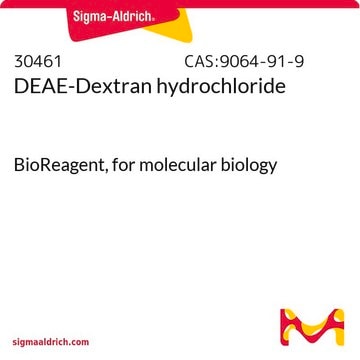B9139
Biotin-dextran
mol wt 10,000, Lysine-fixable
Faça loginpara ver os preços organizacionais e de contrato
About This Item
Produtos recomendados
conjugado
biotin conjugate
forma
powder
peso molecular
10,000
Extensão da rotulagem
~2 mol per mol
cor
white
solubilidade
H2O: soluble 50 mg/mL, clear, colorless to faintly yellow
temperatura de armazenamento
2-8°C
Procurando produtos similares? Visita Guia de comparação de produtos
Categorias relacionadas
Aplicação
Biotin-dextran is used in tissue staining to prepare neurons for detection by avidin-conjugated detection systems. It is taken up by neuronal processes and transported bi-directionally. It infiltrates axon boutons in the anterograde direction and dendritic processes in the retrograde direction. Staining can be observed in fixed and sectioned tissue from two days to two weeks after biotin-dextran is injected into the brain or spinal cord. It can also be applied to cut nerve tracts. Biotinylated neurons are detected by either light or electron microscopy following incubation with avidin-horseradish peroxidase conjugate and the electron-dense substrate 3,3′-diaminobenzidine (DAB).
Outras notas
To gain a comprehensive understanding of our extensive range of Dextrans for your research, we encourage you to visit our Carbohydrates Category page.
Código de classe de armazenamento
11 - Combustible Solids
Classe de risco de água (WGK)
WGK 3
Ponto de fulgor (°F)
Not applicable
Ponto de fulgor (°C)
Not applicable
Equipamento de proteção individual
Eyeshields, Gloves, type N95 (US)
Certificados de análise (COA)
Busque Certificados de análise (COA) digitando o Número do Lote do produto. Os números de lote e remessa podem ser encontrados no rótulo de um produto após a palavra “Lot” ou “Batch”.
Já possui este produto?
Encontre a documentação dos produtos que você adquiriu recentemente na biblioteca de documentos.
Os clientes também visualizaram
Prefrontal cortical inputs to the basal amygdala undergo pruning during late adolescence in the rat.
Victoria L Cressman et al.
The Journal of comparative neurology, 518(14), 2693-2709 (2010-05-28)
Transformations in affective and social behaviors, many of which involve amygdalar circuits, are hallmarks of adolescence in many mammalian species. In this study, using the rat as a model, we provide the first evidence that afferents of the basal amygdala
Bao-Ling Du et al.
Brain research, 1400, 87-98 (2011-06-11)
Delivery of cellular and/or trophic factors to the site of injury may promote neural repair or axonal regeneration and return of function after spinal cord injury. Engineered scaffolds provide a platform to deliver therapeutic cells and neurotrophic molecules. To explore
Jia Liu et al.
Journal of the neurological sciences, 325(1-2), 127-136 (2013-01-16)
The stem cell-based experimental therapies are partially successful for the recovery of spinal cord injury (SCI). Recently, acellular spinal cord (ASC) scaffolds which mimic native extracellular matrix (ECM) have been successfully prepared. This study aimed at investigating whether the spinal
Yang-Can Duan et al.
Pflugers Archiv : European journal of physiology, 459(1), 1-9 (2009-07-25)
This study is to determine whether the nucleus of solitary tract (NTS) is an important component of the central neurocircuitry of the cardiac sympathetic afferent reflex (CSAR) and whether the gamma-aminobutyric acid (GABA) in the NTS modulates the CSAR. Renal
Karen M Fisher et al.
The Journal of comparative neurology, 526(15), 2373-2387 (2018-07-18)
The corticospinal tract (CST) forms the major descending pathway mediating voluntary hand movements in primates, and originates from ∼nine cortical subdivisions in the macaque. While the terminals of spared motor CST axons are known to sprout locally within the cord
Nossa equipe de cientistas tem experiência em todas as áreas de pesquisa, incluindo Life Sciences, ciência de materiais, síntese química, cromatografia, química analítica e muitas outras.
Entre em contato com a assistência técnica








